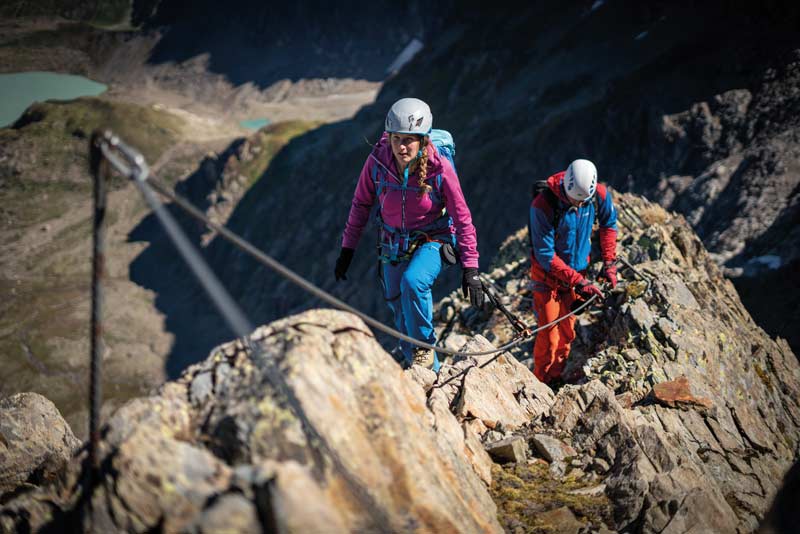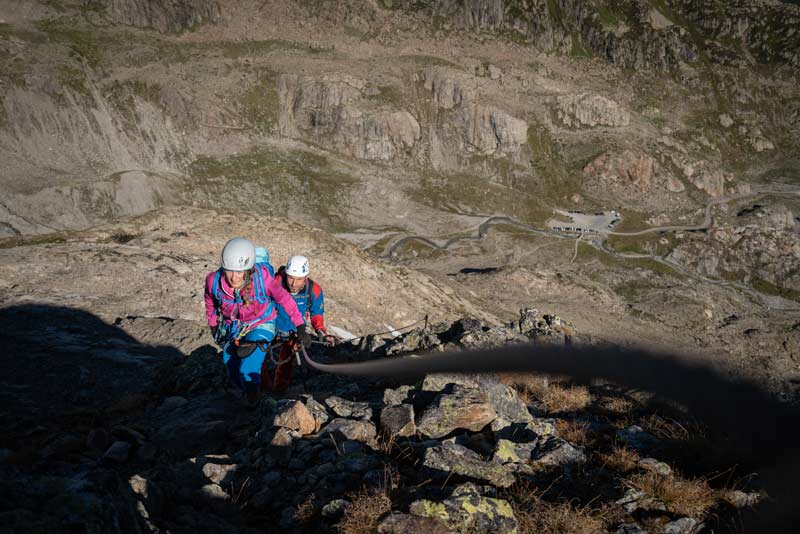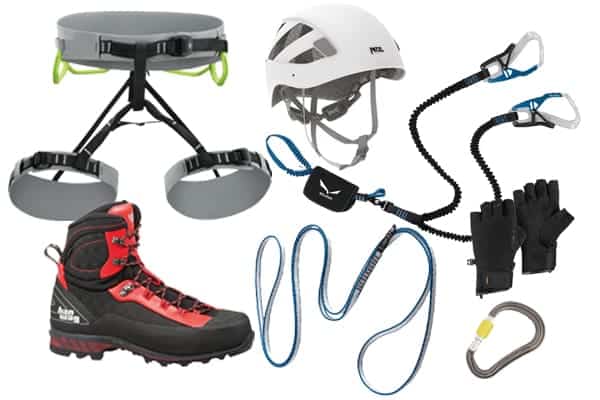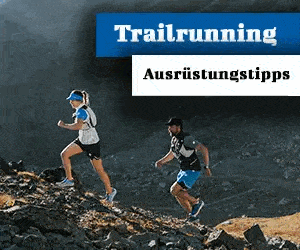Via ferratas are a fantastic mountain experience - and an easily accessible one on top of that. But the same applies here: You have to prepare well for a tour and have the necessary knowledge and equipment. We'll show you what to look out for.
A contribution by Fabian Reichle - Bächli Bergsport
While climbing on a rope through high rock faces requires a lot of material and technical knowledge, with Via Ferrata these are more manageable. But appearances can be deceptive, because there are also dangers lurking on the steel cable. Be it through external influences, overestimation of oneself or a lack of material knowledge. The success of a tour also depends heavily on planning.
It stands and falls with the route planning
As with all alpine sports, careful planning is the be-all and end-all. A via ferrata can only be climbed safely - and ultimately also with pleasure - if you already know in advance what to expect.

Choose the right level of difficulty for the via ferrata
The first indication of feasibility is the difficulty scale. In Switzerland, the so-called Hüsler scale, which is also used by the SAC, is common. This is divided into six levels:
- K1, easy: Usually well-traced climbs, securing in relation to the terrain comfortable. Examples: Schreckhornhütte, Felsenweg Sustlihütte.
- K2, medium: Sections already in steep rocky terrain, but carefully secured. Examples: Rigidalstock, Eiger-Rotstock
- K3, quite difficult: Longer stretches in steep, also exposed rocky terrain. Still carefully secured. Examples: Tälli via ferrata, Via Ferrata Monte Generoso
- K4, difficult: steep rocky terrain with vertical spots. Often considerably exposed. Handles and steps are often small. Examples: Fürenwand, Jägihorn
- K5, very difficult: Most difficult rocky terrain. Example: Final variant Jägihorn
- K6, extremely difficult: only for professionals. Very exhausting and exposed. Solid nerves and top physical condition are required. Example: Daubenhorn
In Austria, the sound scale is mainly used, with the help of which climbing routes are rated from A to F. As with regular climbing, it is recommended that you approach the scale. Only those who have mastered one degree should venture to the next higher level.
As with regular climbing, it is recommended that you approach the scale.
The difficulty scale gives you a rough estimate of what to expect. However, pay attention to details when planning: Are there particularly exposed areas? Does the crux come at the beginning or towards the end? Is the via ferrata more technical or physical? Are there rest areas? Are there any exit options on the route?
Also important and unfortunately often takes a backseat: How is the ascent and descent? Is there maybe even a cable car that will bring you back down?
Weather: Respect for thunderstorms
A well-founded weather check is also part of the mountain sports standard, but special attention must be paid to via ferratas. Remember, you are climbing a steel rope that quickly becomes a lightning rod during a thunderstorm and thus a real danger to life. But rain, wetness and cold can also make a supposedly simple via ferrata much more difficult if the iron material becomes slippery.

Specific via ferrata equipment is worthwhile
On a via ferrata you are at least with the following equipment: Klettersteigset, Climbing harness, Helmet and good mountain boots. For more grip on the metal and to protect your hands, it is best to put on tight-fitting leather gloves. A webbing sling with an HMS carabiner for additional security in locking positions also helps.

Standard and optional equipment on via ferrata: climbing harness, helmet, via ferrata set, mountain boots, gloves, sling, HMS carabiner.
You should pay special attention to your via ferrata set. On the one hand, it is the device that connects you to the safety rope and therefore represents your life insurance. It has to feel good, the handling cannot be too complicated. Let yourself be by ours Advice from professionals and climbs exclusively with standardized, certified via ferrata sets. So check whether your current set complies with the latest regulations.
Modern via ferrata sets are manufactured according to EN 958: 2017. You can read what is hidden behind the cryptic name on one Overview of the German Alpine Club.
The rest of the material meets the standard for activities in the mountains: first aid kit, weather protection, mobile phone. At the SAC you will find a practical one Equipment list.
Before getting started
No start on the via ferrata without a partner check. Controlled with the eyes and hands. Is all the material in perfect condition? Has the via ferrata set been correctly integrated and is the harness properly closed? Does the helmet fit?
Before you start: Never climb a closed via ferrata. Once you're on the wall, there's usually no going back. There are good reasons why a trail is not accessible.
In the via ferrata
The most important rule on the wall: at least one arm of the via ferrata set always stays on the rope. The two carabiners should be attached to the steel cable in opposite directions, this increases safety.
Remember that in the event of a fall, the person in front of you will fall the entire length of the steel cable to the last safety device; the fall arrester of the via ferrata set increases the distance again. If you get too close, you will likely get carried away. The principle is therefore: There is only one person between two fuses. If in doubt, increase the distance.
However, if you are traveling a little faster than the one leading you and want to overtake, then register your intention and talk to you so that you can pass a suitable, safe place.
An often overlooked fact: there is a risk of falling rocks in via ferrata. So be careful where you step to reduce this risk. Of course, the helmet always stays on, even at rest areas or allegedly safe meadow strips in the wall.
Via ferrata tours with children
Climbing a via ferrata with children means a lot of responsibility. Remember that at times children can be inattentive and tire more quickly than adults. Via ferrata sets are also standardized so that they are designed for a minimum weight of 40 kilograms - children often fall below this weight (the upper limit is 120 kilograms, by the way).
If you still want to walk a via ferrata with a child, you should put on a complete harness and you must secure it with a dynamic rope. This technique is similar to that of multi-pitch climbing and mountaineering - those who secure children have to be absolutely sure of their saddle. Remember: The ascent is associated with additional expenditure of time. For the reasons mentioned, we do not recommend via ferratas for children or only for experienced via ferrata climbers who have mastered rope handling.
You can find a detailed overview of the additional securing of ropes on the via ferrata at Petzl.
After the via ferrata tour
Did you notice any material damage during the ascent? Were there loose stones? Report that to those who maintain the via ferrata; you are definitely happy. And while you're at it: Now at the latest it would be advisable to throw one or two francs into the maintenance fund so that your favorite via ferrata will be in good shape and enjoyable for years to come.
Additional links with information on via ferrata
- SAC via ferrata recommendations
- Overview of difficulty scale (Wikipedia)
- Via ferrata climbing with children (technical advisor from Petzl)
- Recall list of via ferrata sets (DAV, as of 2013)
About Bächli mountain sports
Bächli mountain sports is the leading Swiss specialist shop for climbing, mountaineering, expeditions, hiking, ski touring and snowshoeing. At currently 13 locations in Switzerland, Bächli Bergsport offers its customers expert advice and high-quality service. Published on LACRUX Bächli mountain sports periodically exciting contributions to the topics climbing, bouldering and mountaineering.
Do you like our climbing magazine? When we launched LACRUX, we decided not to introduce a payment barrier. It will stay that way, because we want to provide as many like-minded people with news from the climbing scene.
In order to be more independent of advertising revenue in the future and to provide you with even more and better content, we need your support.
Therefore: Help and support our magazine with a small contribution. Naturally you benefit multiple times. How? You will find out here.
That might interest you
+ + +
Credits: picture and text Bächli Bergsport


